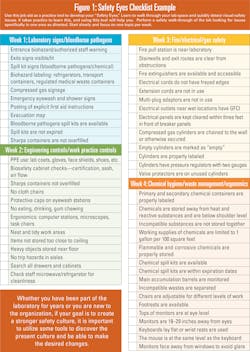Creating a successful safety culture in your laboratory
A laboratory safety expert can walk into a department and assess the safety culture fairly quickly. Some obvious clues include the level of use of personal protective equipment (PPE), the use of personal electronics such as cell phones, visible lab labeling and signage, and the overall appearance of the laboratory. Understanding the lab safety culture can be much more difficult for those who work in the laboratory every day, and this lack of understanding extends from departmental leadership to each and every staff member.
There can be many reasons for a poor lab safety culture, and part of making improvements will involve determining some of those reasons. Busy and inattentive leadership who do not place a priority on safety will do untold damage to the department’s culture. Lab managers and directors may not act intentionally to discourage safety, but simple actions such as dressing inappropriately while entering the department or not noticing or speaking up about blatant safety issues seen throughout the day will chip away quickly at any work being done to bolster safety in the lab. A failing lab safety culture can also come from a lack of safety training and awareness. Labs that do not orient new employees regarding proper work practices, engineering controls, PPE, and other safety procedures will continue to experience safety problems. Safety training, safety topic reviews, and ongoing competency assessments should all be a part of the overall lab safety program.
Whether you have been part of the laboratory for years or you are new to the organization, if your goal is to create a stronger safety culture, it is important to utilize some tools to discover the present culture and be able to make the desired changes.
Safety eyes
An individual’s “Safety Eyes” can be a safety culture assessment tool and a powerful weapon that can be used in the battle for safety culture improvement. Developing and using Safety Eyes is like having a “superpower” that everyone can have. It is so powerful, in fact, that a practiced user can make a good and accurate safety assessment with a quick glance into the department.
To develop Safety Eyes, a novice will need to use a checklist and practice. In the first week, for example, review items associated with bloodborne pathogens. Check for biohazard symbols on waste cans and lab refrigerators and freezers. Look at workbench decontamination logs and see if there are spill kits in appropriate locations. Look for eating or drinking in the department and check for proper PPE use. Perform these same checks for a week, then move on to another area such as chemical management, ergonomics, or fire safety. If you focus on one area at a time, you will begin to train your eyes to see those items automatically when you walk through the laboratory.
Experienced Safety Eyes can notice many safety issues, but that is only part of the power that can make a positive change. Once safety issues are identified, it is just as important that they are reported and fixed. Teaching a team of lab heroes to utilize their abilities to find and mitigate safety issues is a powerful way to assess the safety culture and to strengthen it. For an example of a Safety Eyes checklist, see Figure 1.Safety audits
Performing a safety audit in the laboratory can also be a valuable tool used to gather information about the safety culture. There are many types of audits that can be performed. Organizations like the Clinical Laboratory Standards Institute (CLSI), World Health Organization (WHO), and International Organization for Standardization (ISO), and laboratory accrediting agencies provide audit templates and checklists. A laboratory may create its own audit checklist as well by focusing on specific issues in the department.
Physical environment audits should be performed regularly throughout the year. The laboratory is a dynamic department with multiple moving parts and people, and things can change quickly. Use a physical environment checklist to look for potential fire safety issues, electrical problems, proper storage and labeling, and compressed gas safety items. A full, in-depth laboratory safety audit should be performed at least annually. A scored audit can be used by lab safety staff and leadership to determine improvements in lab safety over time. This can be a useful tool for positive culture change as well — when staff observe or participate in the auditing process, their awareness increases, and they help identify safety issues as they arise.
Make sure all audits are performed carefully and that each checklist item is answered truthfully. If there is no follow up on issues noted on the audit, the lab’s resources and time have been wasted. Perform audits properly and ensure complete follow-up of any problems discovered.
Safety culture assessments
A third tool that can help to gauge the current safety culture in the laboratory is the use of a written or electronic safety culture assessment. You may be able to tell what’s going on visually and physically by the evidence of your eyes and safety audits; however, this assessment tool is a way to actually find out what staff and leadership truly believe about the level of safety in the department.
There are multiple ways to gather information about the safety culture. One assessment survey can be given to leadership, one to those directly responsible for safety, and another to front line staff. There may be differences of opinion about how safety is perceived between different groups, and that alone can be useful knowledge used to help unify and standardize the overall approach to safety. Surveys may be anonymous, or you may wish to identify those providing information. Surveys can be on paper or electronic survey software may be utilized.
Ask participants to rate the current lab safety culture. Get their opinion on what needs improvement and how they would suggest making such changes. Once data is gathered, be sure to analyze it and create an appropriate response. Let respondents know their opinions were heard, that they mattered, and that actions were enacted in response to the survey(s). Safety culture assessments should be repeated at regular intervals in order to see that actions plans are valuable, that safety is improving, and that staff notice the improvements. An assessment can also be a tool that lets staff understand that safety is important in the department and ongoing assessments will help with continued safety awareness. Both of these will benefit the overall safety culture in the long term.
Safety monitors
Reviewing safety data in the laboratory is another method of evaluating the level of safety in the department. Tracking the number of injuries, exposures, spills, and other incidents in the lab provides important data, and certainly a higher number of these accidents may indicate a weaker safety culture. These data points can be used, however, as instruments for making positive changes in the lab.
Each safety incident should be reviewed, have a cause determined, and then have methods of prevention determined. This information should be shared among safety committee members and eventually the staff. Discussing safety accidents raises awareness in the department and sharing details of events will likely keep the incident from happening again. Even near-miss events should be shared.
When a safety issue occurs in the laboratory, it is always important to look at the system that allowed the incident first. The incident could have resulted from a personnel problem, but that is far less common. What policy, process, physical layout, or unusual occurrence permitted the event to occur? Once the investigation is completed and the information is shared, the unfortunate event has been converted into a powerful implement to combat a culture where such incidents can continue.
Opening the toolbox
As a laboratory safety consultant, I am often asked to rate the safety culture in the lab where I have performed an audit and to compare it to others. There is little value in that. The safety culture that exists in your laboratory today is your starting point. This is where safety in the laboratory stands today. If you cannot make a determination, begin by using Safety Eyes, reviewing safety data, and performing a complete safety audit. Once that data is gathered, find out what others think of the state of safety in the department today.
Once you have your starting point, create your action plan for moving forward from your starting point. Changing the safety culture can be a slow process, and you need to focus on what you can do today to make a difference. Remember to focus on the improvement process in the short term and you will make progress toward your ultimate long-term goals each day. Stress the importance of safety with new staff and consistently raise safety awareness with all staff. Find safety champions in the department, and continue using safety assessment tools, even as improvements are seen. By taking these steps, you can become proud to be in a laboratory where safety can be seen no matter who walks through the door to make an assessment.
About the Author

Dan Scungio, MLS(ASCP), SLS, CQA (ASQ)
has more than 25 years of experience as a certified medical tech. He was a lab manager for 10 years before becoming the laboratory safety officer for Sentara Healthcare, a system of 12 hospitals and more than 20 labs and draw sites in Virginia and North Caroline. As “Dan the Lab Safety Man,” he provides consulting, education, and training in the U.S. and Canada.

